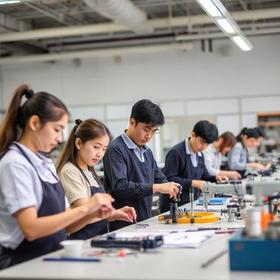- PIA, a premiere school of aviation maintenance, aviation electronics, and electronic systems training, was established in 1929. PIA’s goal has been to provide its learners with the knowledge, skills, and attitudes that they need in order to succeed in their chosen career fields.
School Highlights
Pittsburgh Institute of Aeronautics serves 848 students (100% of students are full-time).
The college's student-teacher ratio of 9:1 is lower than the state community college average of 15:1.
Minority enrollment is 21% of the student body (majority Black and Hispanic), which is less than the state average of 48%.
Quick Facts (2025-26)
- Enrollment: 848 students
- Private-state tuition: $19,125
- Acceptance Rate: 94%
- Student-teacher ratio: 9:1
- Minority enrollment: 21%
- Source: Integrated Postsecondary Education Data System (IPEDS)
School Overview
The teacher population of 98 teachers has stayed relatively flat over five years.
Pittsburgh Institute of Aeronautics
(PA) Community College Avg.
Carnegie Classification
Special Focus Two-Year: Technical Professions
Not applicable, not in Carnegie universe (not accredited or nondegree-granting)
Institution Level
At least 2 but less than 4 years
At least 2 but less than 4 years
Institution Control
Private not-for-profit
Private not-for-profit
Total Faculty
98 staff
59 staff
School Calendar
Student Body
The student population of Pittsburgh Institute of Aeronautics has grown by 36% over five years.
The student-teacher ratio of 9:1 has increased from 6:1 over five years.
The Pittsburgh Institute of Aeronautics diversity score of 0.37 is less than the state average of 0.68. The school's diversity has declined by 15% over five years.
Total Enrollment
848 students
461 students
Student-Teacher Ratio
9:1
15:1
# Full-Time Students
848 students
325 students
# Part-Time Students
n/a
136 students
# Enrollment Undergraduate
848 students
298 students
# Full-Time Undergraduate Students
848 students
326 students
# Full-Time Graduate Students
n/a
10 students
# Part-Time Undergraduate Students
n/a
151 students
# Part-Time Graduate Students
n/a
12 students
Total Dormitory Capacity
n/a
330 students
% American Indian/Alaskan
n/a
n/a
% Asian
3%
5%
% Hispanic
6%
11%
% Black
6%
15%
% White
79%
52%
% Hawaiian
n/a
3%
% Two or more races
4%
3%
% Non Resident races
1%
1%
% Unknown races
1%
10%
Diversity Score
0.37
0.68
College Completion Rate (Students who graduate in less than 4 years)
57%
60%
College Completion Rate (Students who graduate in 4 years or more than 4 years)
n/a
36%
Average Graduate Earnings (10 Years)
$56,800
$34,900
Tuition and Acceptance Rate
The private state tuition of $19,125 is more than the state average of $17,231. The private state tuition has grown by 14% over four years.
Private State Tuition Fees
$19,125
$17,231
% Students Receiving Some Financial Aid
85%
88%
Median Debt for Graduates
$14,498
$13,000
Median Debt for Dropouts
$5,500
$6,260
Acceptance Rate
94%
74%
SAT Reading
n/a
460
SAT Math
n/a
470
SAT Writing
n/a
435
ACT Composite
n/a
20
ACT English
n/a
20
ACT Math
n/a
21
ACT Writing
n/a
7
Source: 2024 (or latest year available) Integrated Postsecondary Education Data System (IPEDS)
School Notes
- In 1995 PIA expanded its training to meet other needs in the transportation industry with the addition of its Truck Driving Program. As skilled commercial drivers are always in demand, this course of study provides a much-needed training program in several locations in Pennsylvania and West Virginia. In 2003 PIA again expanded its course offerings to include Heavy Equipment Operation, Corporate Training, and Computer Based Training for youth and adults. Pittsburgh Institute of Aeronautics is located eight miles south and east of the city of Pittsburgh with its campus buildings on Allegheny County Airport, West Mifflin, PA. PIA's airport location provides an ideal atmosphere for aviation training and access to the airport runways so that the airplanes that are worked on in PIA's shops can fly to the school's facilities. The total area of school facilities is more than 120,000 square feet. In addition to classrooms and laboratory areas, the campus houses a bookstore, libraries, and printing department. Programs Offered includes Aviation Maintanence Technology (AMT), Aviation Electronics Technology (AET), Electronics Systems Technology (EST), Mechanical Systems Technology (MST), Commercial Drivers License Training (CDL), Heavy Equipment Operator (HEQ) and Rotorcraft Systems & Maintenance (RSM). The institute is accredited by the Accrediting Commission of Career Schools and Colleges of Technology (ACCSCT).
Frequently Asked Questions
How much does Pittsburgh Institute of Aeronautics cost?
Pittsburgh Institute of Aeronautics's private state tuition is approximately $19,125.
What is the acceptance rate of Pittsburgh Institute of Aeronautics?
The acceptance rate of Pittsburgh Institute of Aeronautics is 94%, which is higher than the state average of 74%.
Recent Articles

The Rise of Technical and Vocational Training in 2025
Explore the 2025 surge in technical and vocational training—enrollment, policy, costs, and why this path is gaining ground for students and parents.

Stackable Credentials: How Community Colleges Advance Careers
Discover how community colleges use stackable credentials to build career pathways, boost earnings, and enable lifelong learning in 2025.

High-Paying Jobs You Can Get with a Community College Degree
Discover top high-paying careers you can launch in 2025 with a community college (associate) degree and high-growth credentials in tech, healthcare and trades.










